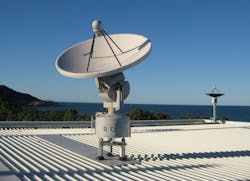Space experts reach out to industry for enabling technologies in satellite mission planning, cyber security
KIRTLAND AIR FORCE BASE, N.M. – U.S. Air Force satellite experts are surveying industry to find companies with enabling technologies and know-how for satellite mission planning, cyber security, payloads, sensors, and on-orbit control.
Officials of the Hybrid Architecture Demonstrations team in the Air Force Research Laboratory at Kirtland Air Force Base, N.M., issued a request for information (FA945323Q0R01) on Wednesday for the Satellite Systems project.
Researchers are investigating hybrid space architectures that consist of integrated systems of commercial, allied, and U.S. government satellite systems.
The Air Force is seeking new technologies to help manage mission planning for the hybrid space architecture to improve deterrence and resilience in space while providing new information for science, commerce, and security, officials say. This request for information is to deliver a fresh look at current and emerging satellite mission planning capabilities.
This information request seeks satellite mission planning system capabilities like tracking and forecasting the characteristics of orbiting satellites; and satellite payloads based on size, orbit, provider, and operational modes.
Satellite sensor types of interest include electro optical; automatic identification system (AIS); hyperspectral and multispectral imagery; RF sensors; synthetic aperture radar; automatic dependent surveillance – broadcast; full motion video; weather forecasts; and cell phone communications.
Requirements for tasking a satellite through a request for collection include a 30-minute collection window; tasking lead time, data delivery and latency; percentage of cloud cover; minimum and maximum required angles; location; contract being used; priority; specific network access identifier; once, daily, weekly, some other schedule; and sensor modes.
Such a satellite mission planning system will enable operators to plan for collecting satellite data for tasking systems and for satellite data providers.
Responses of this RFI should come from companies with satellite mission planning capabilities, and should include information about ground antennas, tracking stations, networks, tasking, and application interfaces for tasking.
Responses should highlight existing capabilities, experience, and demonstrated performance, including latencies and accuracy of satellite mission planning.
Companies interested should upload 15-page responses no later than 3 March 2023 to https://sam.gov. Email questions or concerns to the Air Force's Kate Yoshino at [email protected], Alex Pena at [email protected], or Peter Brzezicki at [email protected].
More information is online at https://sam.gov/opp/c81d66ce4aaa44a9a2433c97b3f67ff4/view.
About the Author
John Keller
Editor-in-Chief
John Keller is the Editor-in-Chief, Military & Aerospace Electronics Magazine--provides extensive coverage and analysis of enabling electronics and optoelectronic technologies in military, space and commercial aviation applications. John has been a member of the Military & Aerospace Electronics staff since 1989 and chief editor since 1995.
